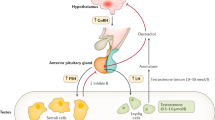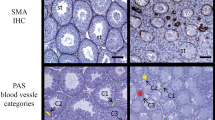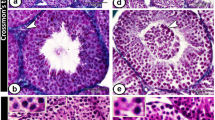Abstract
IN a series of embryological experiments on rabbits and rats, Jost et al.1 have shown that the manifestation of the male or female phenotype is strictly dependent on the presence or absence, respectively, of testosterone. The Müllerian inhibitor formed by the seminiferous tubules2 only seems to be responsible for the retrogression of the Müllerian ducts. Thus, testosterone synthesised in foetal testes3 is the chief organiser of masculine differentiation; a female phenotype results from the absence of testosterone. Accordingly, Ohno4 defined maleness as the induced and femaleness as the noninuced state of genital differentation. The androgenic effects on the development of the genital structures occur during successive critical phases. For instance, the stabilisation of the Wolffian ducts in the rat occurs between days 17 and 18 (ref. 1) while the prostate is imposed on day 21 of foetal life. The imprinting of the rat hypothalamus into the male direction, responsible for the masculine secretory pattern of pituitary gonadotrophins and behaviour pattern, is established during the first two days of postnatal life5. Castration, hypophysectomy or injections of cyproterone acetate (a highly potent anti-androgen) before these critical stages prevent the differentiation processes but by later treatment the development is no longer affected. Similar developmental patterns may be applicable to man except for hypothalamus differentiation which is fixed as early as in the fifth month of intrauterine life6. Full maturity of the genital structures and particularly the onset of sperm production, are both dependent on testicular androgens, so occur rather late during the postnatal life of all mammalian species.
This is a preview of subscription content, access via your institution
Access options
Subscribe to this journal
Receive 51 print issues and online access
$199.00 per year
only $3.90 per issue
Buy this article
- Purchase on Springer Link
- Instant access to full article PDF
Prices may be subject to local taxes which are calculated during checkout
Similar content being viewed by others
References
Jost, A., Vigier, B., Prépin, J., and Perchellet, J. P., Rec. Progr. Horm. Res., 29, 1 (1973).
Josso, N., Endocrinology, 93, 829 (1973).
Noumoura, T., Weisz, J., and Lloyd, C. W., Endocrinology, 78, 245 (1966).
Ohno, S., Hereditas, 69, 107 (1971).
Harris, G. W., Endocrinology, 75, 627 (1964).
Dörner, G., Sexualhormonabhängige Gehirndifferenzierung und Sexualität (Springer-Verlag, Wien-New York, 1972).
Catt, K. J., Dufau, M. L., Nature new Biol., 244, 219 (1973).
Reyes, F. I., Winter, J. S. D., and Faiman, C., J. clin. Endocr. Metab., 37, 74 (1973).
Frowein, J., Engel, W., Weise, H. Ch., Nature new Biol., 246, 148 (1973).
Lording, D. W., and De Kretser, D. M., J. Reprod. Fert., 29, 261 (1972).
Mancini, R. E., Vilar, O., Lavieri, J. C., Andrada, J. A., and Heinrich, J. J., Am. J. Anat., 122, 203 (1963).
Sullivan, J. V., and Strott, C. A., J. biol. Chem., 248, 3202 (1973).
Luck, D. N., Gschwendt, M., Hamilton, T. H., Nature new Biol., 245, 24 (1973).
Author information
Authors and Affiliations
Rights and permissions
About this article
Cite this article
FROWEIN, J., ENGEL, W. Constitutivity of the HCG-receptor protein in the testis of rat and man. Nature 249, 377–379 (1974). https://doi.org/10.1038/249377a0
Received:
Revised:
Issue Date:
DOI: https://doi.org/10.1038/249377a0
This article is cited by
-
HCG-insensitivity of the postnatal rat ovary is due to the lack of a specific receptor
Experientia (1977)
-
On the influence of the hypothalamic-hypophysial system on the developing Leydig cells
Anatomy and Embryology (1976)
-
Glucocorticoids and hCG sensitivity of rat testicular Leydig cell
Nature (1974)
Comments
By submitting a comment you agree to abide by our Terms and Community Guidelines. If you find something abusive or that does not comply with our terms or guidelines please flag it as inappropriate.



